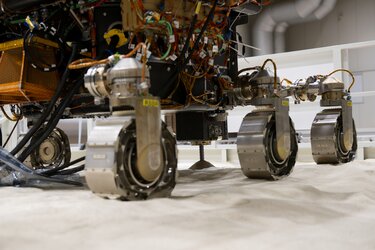Accept all cookies Accept only essential cookies See our Cookie Notice

About ESA
The European Space Agency (ESA) is Europe’s gateway to space. Its mission is to shape the development of Europe’s space capability and ensure that investment in space continues to deliver benefits to the citizens of Europe and the world.
Highlights
ESA - United space in Europe
This is ESA ESA facts Member States & Cooperating States Funding Director General Top management For Member State Delegations European vision European Space Policy ESA & EU Space Councils Responsibility & Sustainability Annual Report Calendar of meetings Corporate newsEstablishments & sites
ESA Headquarters ESA ESTEC ESA ESOC ESA ESRIN ESA EAC ESA ESAC Europe's Spaceport ESA ESEC ESA ECSAT Brussels Office Washington OfficeWorking with ESA
Business with ESA ESA Commercialisation Gateway Law at ESA Careers Cyber resilience at ESA IT at ESA Newsroom Partnerships Merchandising Licence Education Open Space Innovation Platform Integrity and Reporting Administrative Tribunal Health and SafetyMore about ESA
History ESA Historical Archives Exhibitions Publications Art & Culture ESA Merchandise Kids Diversity ESA Brand Centre ESA ChampionsLatest
Space in Member States
Find out more about space activities in our 23 Member States, and understand how ESA works together with their national agencies, institutions and organisations.
Science & Exploration
Exploring our Solar System and unlocking the secrets of the Universe
Go to topicAstronauts
Missions
Juice Euclid Webb Solar Orbiter BepiColombo Gaia ExoMars Cheops Exoplanet missions More missionsActivities
International Space Station Orion service module Gateway Concordia Caves & Pangaea BenefitsLatest
Space Safety
Protecting life and infrastructure on Earth and in orbit
Go to topicAsteroids
Asteroids and Planetary Defence Asteroid danger explained Flyeye telescope: asteroid detection Hera mission: asteroid deflection Near-Earth Object Coordination CentreSpace junk
About space debris Space debris by the numbers Space Environment Report In space refuelling, refurbishing and removingSafety from space
Clean Space ecodesign Zero Debris Technologies Space for Earth Supporting Sustainable DevelopmentApplications
Using space to benefit citizens and meet future challenges on Earth
Go to topicObserving the Earth
Observing the Earth Future EO Copernicus Meteorology Space for our climate Satellite missionsCommercialisation
ESA Commercialisation Gateway Open Space Innovation Platform Business Incubation ESA Space SolutionsLatest
Enabling & Support
Making space accessible and developing the technologies for the future
Go to topicBuilding missions
Space Engineering and Technology Test centre Laboratories Concurrent Design Facility Preparing for the future Shaping the Future Discovery and Preparation Advanced Concepts TeamSpace transportation
Space Transportation Ariane Vega Space Rider Future space transportation Boost! Europe's Spaceport Launches from Europe's Spaceport from 2012Latest

Deep drilling for Mars
Thank you for liking
You have already liked this page, you can only like it once!
Roam Mars, find an interesting spot and drill deeper than any other rover has before, about 25 times deeper. ESA’s Rosalind Franklin rover twin is testing its drilling potential on a martian-like terrain to simulate the unearthing of signs of life on the Red Planet.
This is not the first, but the third time the test rover reaches the 1.7-metre-deep mark. Engineers call the wheeled laboratory Amalia, a name borrowed from renowned aerospace engineer Amalia Ercoli Finzi, and they use it to recreate what Rosalind Franklin will do on the Red Planet.
The rover’s deep drilling action happened last February. Amalia took its time to perforate a well filled with soil – soft silica on the surface, followed by layers of sand and fine volcanic soil, all of them resembling what Rosalind the rover will encounter under the martian surface.
The ExoMars drill relies on an automated choreography of tools and rods. The drill deploys and retracts to form a ‘drill string’ of up to two metres of length.
The depth is dictated by the mission scientists’ wish list – the research community wants to dig deep to access well-preserved organic material from four billion years ago, when conditions on the surface of Mars were more like those on infant Earth.
On day three of the test excavation, the drill stretched almost to its maximum and reached its target – a gypsum mineral from the Turin region, commonly found in sedimentary deposits linked to water.
The drill acquired a sample in the shape of a pellet of about 1 cm in diameter, brought it to the surface and delivered it to the laboratory that is inside the rover’s belly. During the whole operation, Amalia sent scientific data to the Rover Operations Control Centre (ROCC), the operational hub that will orchestrate the roaming of the European-built rover on Mars.
In the tests that followed, the science team had to come up with a plan for the next sol, or martian day, to command the rover’s actions. In addition to analysing the mix of data from the drilling operations, they worked with data from other Mars-like samples and images of the sample and the drilling spot.
If you are curious about the status of the ExoMars Rosalind Franklin mission, visit this page with frequently asked questions and follow us on @ESA_ExoMars.
The drill was developed by the Italian company Leonardo, while Thales Alenia Space is the prime contractor for ExoMars.
-
CREDIT
ESA – S. Corvaja -
LICENCE
ESA Standard Licence

Amalia drills deep down

Rosalind Franklin rover drilling test

Wheels detail of ExoMars Amalia rover

ExoMars drill ready for sample transfer















 Germany
Germany
 Austria
Austria
 Belgium
Belgium
 Denmark
Denmark
 Spain
Spain
 Estonia
Estonia
 Finland
Finland
 France
France
 Greece
Greece
 Hungary
Hungary
 Ireland
Ireland
 Italy
Italy
 Luxembourg
Luxembourg
 Norway
Norway
 The Netherlands
The Netherlands
 Poland
Poland
 Portugal
Portugal
 Czechia
Czechia
 Romania
Romania
 United Kingdom
United Kingdom
 Slovenia
Slovenia
 Sweden
Sweden
 Switzerland
Switzerland

























